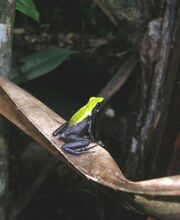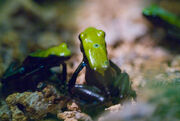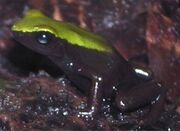| Climbing Mantella | |
|---|---|
 | |
| Physical description | |
| Binomial name | Mantella laevigata |
| Habitat | Tropical rainforest |
| Lifespan | 8-12 years |
| Average Size | 2.5-3.0 cm (1.0-1.2 in) |
| Average weight | 1.3-2.5 grams |
| Diet | Insectivorous |
| Conservational Status | |
| Status | Endangered |
| IUCN status | 3.1 |
| Scientific classification | |
| Kingdom | Animalia |
| Phylum | Chordata |
| Class | Amphibia |
| Order | Anura |
| Family | Mantellidae |
| Genus | Mantella |
| Species | M. laevigata |
| Distribution | |
| Distribution of species | Northeastern Madagascar |
The Climbing Mantella, Mantella laevigata, is a species of Mantella native to northeastern Madagascar. It is thought to be the sister taxon of M. expectata. M. laevigata is threatened by habitat loss, chytridiomycosis, and illegal exportation. It is occasionally kept as a pet by herpetoculturists.
Poison[]
The climbing Mantella produces pumiliotoxin, a potent nerve poison manufactured and stored in subcutaneous membranes and secreted through a modified layer of epidermis. Mantella laevigata, while not the most toxic poison dart frog, is still a highly toxic animal. The very small amount of poison the frog possesses is still enough to make a human ill. Like most Mantellas, however, M. laevigata will only release its poison if it feels that it is threatened, and wild specimens can be handled if the human holding it is calm and relaxed. The climbing Mantella, as with all Mantellas, loses its toxicity in captivity due to a change in diet. This has led scientists to believe that laevigata actually takes its poison from the insects it feeds on.
Pumiliotoxin is deadly in high concentrations. Pumiliotoxin is weaker than allopumiliotoxin and especially batrachotoxin, with a lethal dose of 2 mg (M. laevigata carries about two thirds of a milligram). There are three different types of this toxin A, B and C. Toxins A and B are significantly more toxic than C. Pumiliotoxins affect the body because they interfere with muscle contraction in the heart and skeletal muscle. The toxin works by affecting the calcium channels. Some of the symptoms of pumiliotoxins are partial paralysis, having difficulty moving, being hyperactive and in some cases it can result in death.
Description[]

Wild specimen in Madagascar.
The climbing Mantella is one of the larger Mantellas, with males reaching a length of 2.5 cm and females reaching a length of 3.0 cm. Males are more slimline than females, but both sexes are comparatively thin. Unlike some other Mantellas, size is one of the more consistent means of sexing M. laevigata.
Mantella laevigata is more consistently coloured than many other Mantellas, and there is little variation between individuals. The lower dorsum, flanks, belly, and limbs are solid black, and the upper dorsum and the top of the head are green. The green may be yellowish, lime, or bright and often catches the eye, advertising the frogs' toxicity.
While it is genetically close to the blue-legged Mantella, the climbing Mantella has a markedly different appearence. In addition to having different colouration, climbing Mantellas are often thinner and more elongated in appearence. Also, their calls are shorter, higher-pitched, and much more rapid than the calls of blue-legged Mantellas.
Behaviour[]
The climbing Mantella is a primarily arboreal frog, living on low-growing plants and into the understory of the rainforest; only very occasionally are they seen on the forest floor. Mantella laevigata is a communal frog, living in small groups of interacting individuals. These groups are not territorial, and family groups of climbing Mantellas may live alongside one another. During the breeding season Mantella laevigata become territorial and aggressive, but during the majority of the year they are not excessively so.
Reproduction[]

Courtship.
As with Mantella expectata, the climbing Mantella has an unusual reproductive cycle, comparable to that of the unrelated poison dart frog, Oophaga lehmanni.
The first stage of the breeding cycle is similar to that of most other Mantellas. At the beginning of the rainy season, groups of M. expectata gather around damaged bamboo. As the rain starts falling, males begin to call to females with a sound that has been described as like pebbles clicking together. Males will wrestle in order to clear breeding spaces, but injuries rarely result from such conflicts. Larger and more powerful males are more popular among females, and females may grapple to mate with a single male.
Once the courtship is complete, the female lays a single egg inside a pool of water that accumulates in the centre of a bamboo stem. The male fertilizes the egg, and then leaves the female to care for it. The female protects the egg, and when it hatches, she produces unfertilized eggs for the tadpole to eat. When the tadpole metamorphoses into a froglet, the froglet is led by the female to an existing group.
In captivity[]

Captive specimen.
Wild-caught M. laevigata are frequently encountered in the pet trade during certain times of the year. Captive breeding is also occasionally achieved, and captive-bred frogs are periodically offered for sale. Because of their unique breeding habits, only small numbers of frogs are usually produced when compared with other species of mantellas that are bred, so although they seem to breed more consistently than some other species, there often are few captive-bred frogs available.